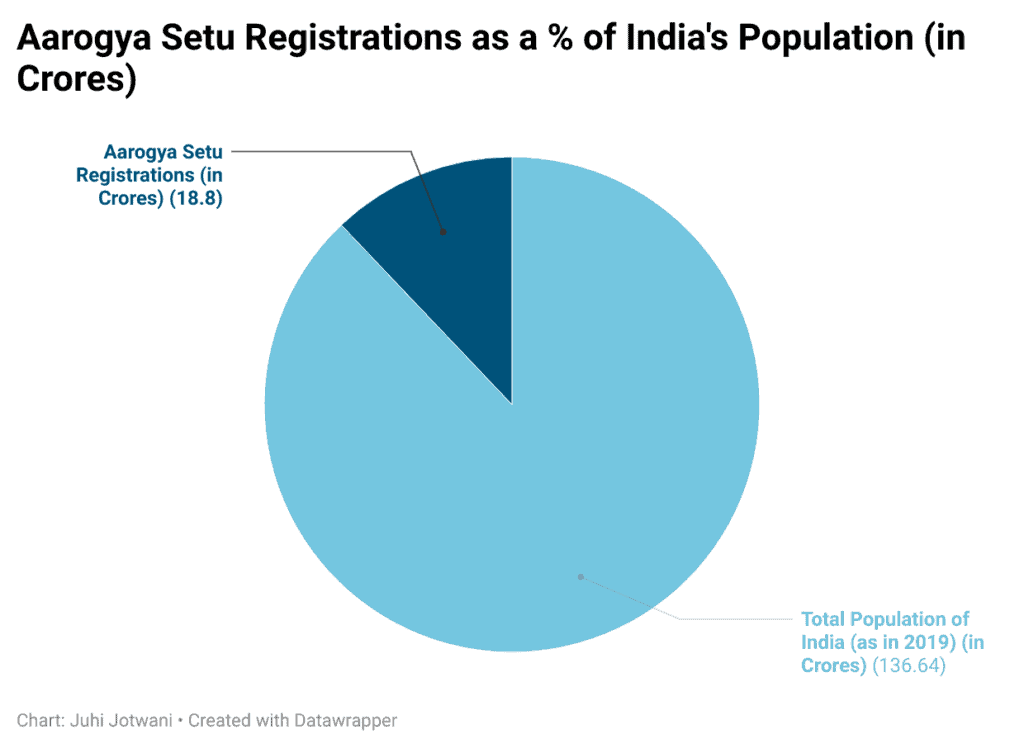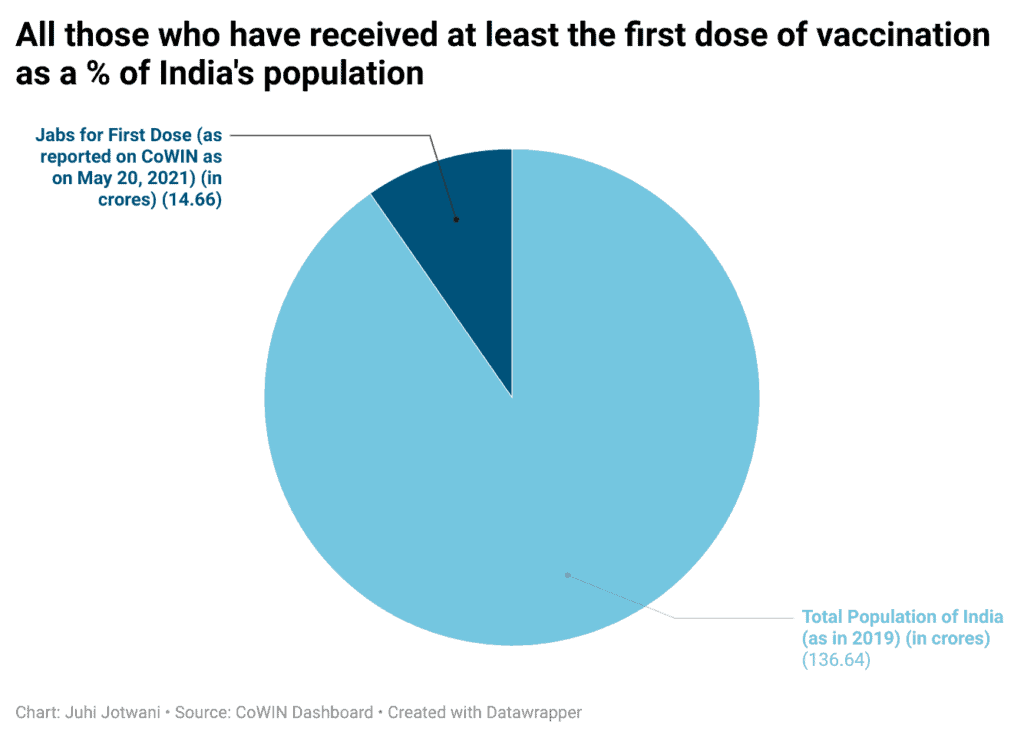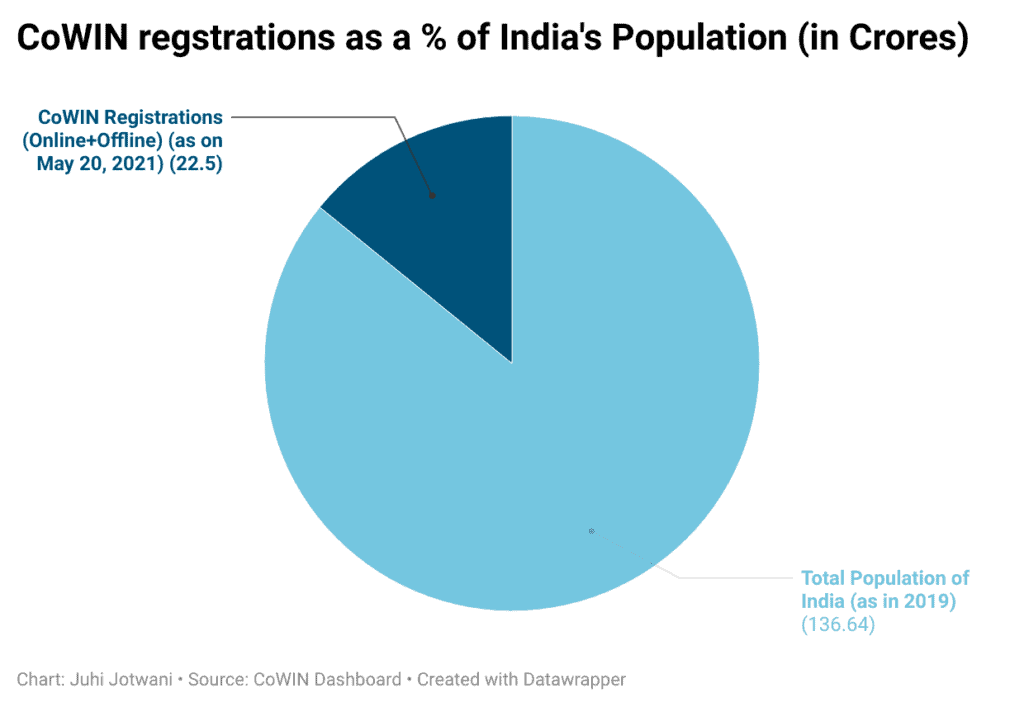Never has a vaccination drive in India been conducted with a mobile application that requires online registration. As the second wave takes its toll — with rising infections and reducing tests — access to the country’s limited health infrastructure is becoming all that more difficult, thanks to the digital divide. Whether it is looking for slots on CoWIN or raising an SOS alert for oxygen, medical relief for COVID has to be accessed and circulated through the digital medium.
When SOS alerts on Twitter reduced in the last few days, there was a false illusion that the COVID situation was improving. What was overlooked was that only a little over 1% of Indians use Twitter. Instead of making lives easier and health accessible, technology appears to be keeping away a majority of the country’s population – informal workers, Dalits, Bahujans, Adivasis, and women — from COVID care.
Take Aarogya Setu — the one-stop portal for information, vaccination, and testing — for instance. It was launched amid much fanfare last year. In fact, it was even mandatory for air travel last year. However, less than 20% of the country’s population is registered on it.

While it is common knowledge that the percentage of Indians who are fully vaccinated is in single digits, it will be wrong to only blame it on the shortage in vaccines. If it was only about shortage of vaccines, more people would have registered on the app, if not booked a slot. Even the percentage of those who have registered is grossly low.
CoWIN is available only in the English language and is automatically inaccessible to those who do not know the language. Social technologist Kiran Jonnalagadda asks, “How could you build a national program that does not speak in any majority languages in this country?”


Even though Aarogya Setu is the highest downloaded app, it still has 19 crore users. Assuming that there will be some 15 crore users. Even then, if we assume that every family has one Aarogya Setu user, it is 60 crores. Doesn’t even cover 50 crores of our population. Majority of people are not on this platform that is supposed to be the single-window platform to get support on tracking of cases and vaccination
Aniket Doegar, CEO and Co-Founder of Haqdarshak
Digital exclusion does not operate in isolation. It exists in the intersection of gender, caste, class, and region. It worsens already-existing barriers to health and information. For instance, as the report below shows, a majority of women do not own mobile phones or use the internet. It is often the male members of a household who have mobile phones and it is through them that women access the digital world.

Clearly, historically oppressed communities bear the brunt of the digital divide, and there would be a stark caste and gender divide in how access is made possible.
By the very fact that someone lives in an area of poor internet connectivity, whether rural or urban, they will lose out on getting a vaccination appointment, because about a 1000 vaccination slots online get booked in a span of 30 seconds to 4 minutes. If that is the time-frame, then it is not only those who have some kind of access to the internet, but those who have ready access to devices, fast and reliable internet connections, and digital skills wo will be able to book it.
Rohini Lakshané (Technologist and Public Policy Researcher)
Creme-de-la-creme
Digital divide is not a new phenomenon in India. Even last year, we saw online learning make education inaccessible and unaffordable for a large numbers of students across age groups. Perhaps, the reason this divide is receiving attention now is because even those who have access to the technology are finding it difficult to access health and medical resources.
Read More: Access to schooling: Will 2021 further deepen the divide?
Kiran Jonnalagadda elaborates, “What’s happening with the vaccine is that it is not just limiting itself to programmers but also to the hyper-aware. Those who are receiving news by the second and not by the day are the ones who are using it first. So, your existing privilege does not work.”
At the same time, it is those who are privileged enough to get instant alerts on Twitter or Telegram who have an advantage over everyone else. “The ability to exercise these privileges is always a function of someone else who was supposed to provide these services not doing their job properly. If the government had planned for vaccine acquisition, then it would not be limiting the reach to the privileged. Someone else’s failure always benefits a certain privileged class but the definition of privilege keeps changing with time,” says Kiran.

This technology also enables the tech-savvy to get ahead of the system. ” People are travelling for hours to some rural area to get vaccinations. People are not waiting for their chance because they can get ahead of the system. The person for whom that vaccination slot has been opened, which ideally is someone in the Gram Panchayat’s jurisdiction, probably doesn’t know, hasn’t gotten registered, is not on CoWIN, doesn’t have an Aadhar Card. So, someone else who is ahead in the digital system is getting it done, says Aniket Doegar, co-founder of Haqdarshak.
Lack of information = misinformation
A report titled “Workers and the Pandemic” was released in May 2021 by All India Central Council for Trade Unions (AICCTU) in collaboration with Garment and Textiles Workers Union (GATWU) and Domestic Workers Rights Union (DWRU). It revealed that 83% of the workers are completely unaware of the government helpline and 84% of them do not know that they can approach COVID-19 Care Centers in case they have symptoms and would like to isolate themselves.
Advocate Maitreyi Krishnan from AICCTU explains, “Because the government is only disseminating information through WhatsApp and social media, a lot of people on the ground don’t know. What we also demand is that information be given by going to these various places, whether it is by auto announcements or door-to-door campaigns.” Maitreyi, has put out a petition, in the name of the Communist Party of India (ML), against the use of CoWIN to administer vaccines.
Read More: Opinion: How ‘privatisation’ and ‘PPP models’ have left Indians to die
Issac Arul Selva, Editor of Slum Jagattu, speaks of the plight of slum-dwellers: “Most people here don’t have smartphones. They only have button-phones. Even for those who have smartphones, they find it difficult to type their name and details of their documentation in English. They also have no way to get correct information. There is a PHC here but they have not been able to go there because they are working during the PHC timings.”
Vannamma, a domestic worker, said that she depends on her employer for information on COVID. This is the case for many other domestic workers. Instead of information being disseminated in an accessible manner, it is often only available to internet users while the rest are left to their own devices to figure things out.
[to be continued]
The poor,the under privileged, people who don’t have an Aadhar card,every person in the state just have access to vaccination and other healthcare services.